For a pollinator-friendly privacy fence, combine tall evergreens like Green Giant Arborvitae or Skip Laurel with flowering natives such as Milkweed, Bee Balm, and Asters. Plant in three tiers: evergreens (back) at 5 feet apart, mid-height shrubs (middle) at 3-4 feet apart, and perennials (front) at 1-2 feet spacing. This layered approach creates year-round screening while supporting bees and butterflies throughout the growing season. The following strategies will transform your boundary into a thriving ecosystem.
Selecting Four-Season Evergreen Privacy Shrubs
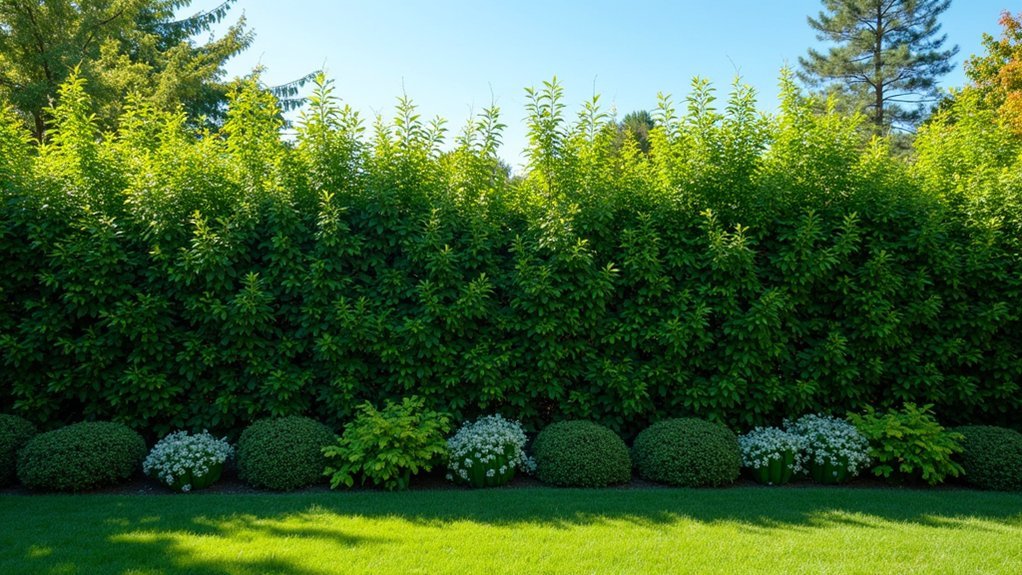
When planning a pollinator-friendly privacy fence, evergreen shrubs form the essential backbone that provides screening throughout all seasons.
Green Giant Arborvitae and Leyland Cypress offer impressive height potential of 20-30 feet with substantial width of 10-20 feet, creating robust natural barriers with rapid growth rates.
Towering evergreen sentinels that quickly establish living walls while creating impressive natural boundaries for your landscape.
For more compact spaces, consider Emerald Green Arborvitae, which reaches 12-15 feet tall with a narrow profile and dense bright green foliage.
Skip Laurel adds versatility with its glossy leaves and spring-blooming fragrant white flowers that attract pollinators.
For the most ecological value, incorporate native plants alongside evergreen privacy shrubs.
Mixing varieties like Hicks Yew with pollinator-friendly plants such as Popcorn Viburnum creates a layered, diverse fence that supports wildlife while maintaining year-round privacy.
Flowering Plants That Attract Bees and Butterflies
Although evergreens provide year-round structure, it’s the flowering plants that transform your privacy fence into a pollinator paradise. By selecting species that bloom in sequence, you’ll create a continuous nectar source throughout the growing season.
Start with Lanceleaf Coreopsis for early-season color from May to July, followed by Milkweed and Bee Balm that sustain monarch butterflies and bumblebees through summer.
Add Blazing Star’s purple spikes in mid to late summer to draw in a variety of butterfly species.
For fall feeding, incorporate Aster varieties that bloom through October and Showy Goldenrod (July-September).
These flowering plants guarantee your pollinator gardens remain active from spring through autumn, creating a privacy fence that’s both functional and ecologically valuable—attracting pollinators while beautifying your landscape.
Strategic Planning for Natural Boundary Plantings
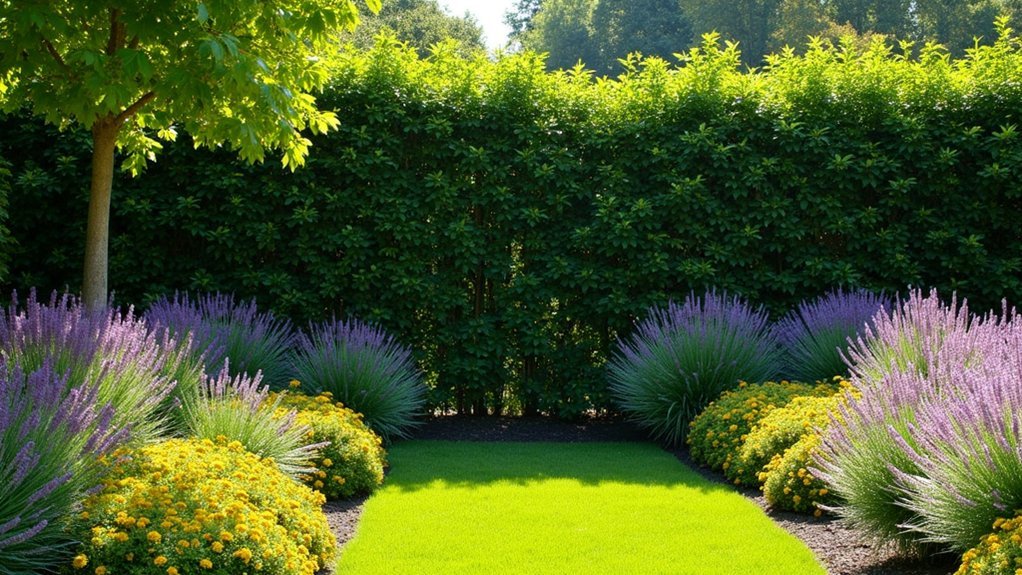
Creating a successful pollinator privacy fence requires thoughtful planning that balances screening needs with ecological benefits. When designing your boundary, incorporate a mix of evergreen shrubs for year-round privacy alongside flowering pollinator plants that provide food sources throughout the seasons.
| Plant Type | Privacy Function | Pollinator Benefit |
|---|---|---|
| Evergreen shrubs | Year-round screening | Winter shelter |
| Flowering natives | Seasonal density | Nectar and pollen |
| Tall grasses | Lower-level fill | Nesting material |
Space your plants strategically—3 to 5 feet apart for most species—making sure they’ll create a dense barrier while still allowing pollinators access to blooms. Select native species whenever possible, as they’re adapted to local conditions and better support regional pollinators. Remember to take into account your specific climate and soil conditions when choosing plants to guarantee they’ll thrive with minimal maintenance.
Combining Heights and Textures for Effective Screening
Creating a three-tier structure with tall evergreens like Leyland Cypress, mid-height flowering shrubs, and ground-level perennials will establish a dynamic privacy fence that supports pollinators year-round.
You’ll want to layer plants of diverse heights, positioning taller species like Green Giant Arborvitae (20-30 feet) at the back and gradually stepping down to shorter options such as Lanceleaf Coreopsis (1-2 feet) at the front.
Textural contrast matters tremendously in your pollinator privacy fence—combine the glossy foliage of Skip Laurel with the feathery texture of Butterfly Bush to create visual interest while providing varied habitats for beneficial insects.
Three-Tier Structure Design
When planning your pollinator privacy fence, a three-tier structure delivers both superior screening and ecological benefits. This layered approach uses plants of varying heights to create dense foliage that serves as both a visual barrier and pollinator habitat.
| Tier | Height Range | Recommended Plants | Spacing | Function |
|---|---|---|---|---|
| Back | 20-30 feet | Green Giant Arborvitae, Leyland Cypress | 5 feet | Primary screening |
| Middle | 12-15 feet | Skip Laurel, Butterfly Bush | 3-4 feet | Texture variation |
| Front | 1-4 feet | Milkweed, Aster, Ornamental Grasses | 1-2 feet | Pollinator support |
Position your tallest evergreens at the back, ensuring proper spacing for complete coverage. The middle tier adds textural interest with glossy and feathery elements, while the front layer attracts diverse pollinators with seasonal blooms and color changes.
Layer With Diverse Heights
While the three-tier structure provides an organizing framework, the artful combination of specific heights and textures elevates your privacy fence into both a functional barrier and visual masterpiece.
Position towering Green Giant Arborvitae (20-30 feet) at the back, creating a formidable boundary while protecting shorter plants from harsh winds.
In the middle, introduce medium-height native shrubs like Viburnum (3-6 feet) that attract butterflies and offer seasonal interest.
Complete your living screen with shorter elements like Blueberry Bushes and Milkweed (1-2 feet) that provide ground-level density.
This strategic layering creates depth that’s visually appealing and functionally superior to single-height barriers.
The varied textures—from dense Leyland Cypress to delicate Bee Balm—maintain privacy year-round while offering changing scenes of color, form, and wildlife activity throughout seasons.
Textural Contrast Matters
The magic of an effective pollinator privacy fence emerges from textural contrast, not just height variation. When you combine soft, feathery perennials like Aster with denser shrubs for privacy such as Skip Laurel, you create a rich, multi-dimensional screen that delights the eye while supporting diverse wildlife.
This textural interplay serves multiple purposes in your pollinator garden: it creates visual interest, breaks up the monotony of uniform plantings, and provides varied habitats for beneficial insects.
Try incorporating ornamental grasses among your privacy shrubs to add movement and a sensory element that responds to even the slightest breeze. This dynamic approach transforms a simple barrier into a living tapestry where different leaf shapes, plant structures, and growth habits work together to create both beauty and functionality throughout the seasons.
Native Species for Sustainable Pollinator Habitats
Native milkweed and tall asters create essential host plant partnerships for monarchs and swallowtails while forming the backbone of your living fence.
You’ll strengthen your garden’s ecological value by pairing these host plants with complementary native flowering shrubs like ninebark or buttonbush that provide both food for pollinators and visual screening.
Structuring these plantings in graduated layers—with taller woody natives at the back and mid-height perennials in front—offers both sustainable pollinator habitat and effective privacy throughout the seasons.
Host Plant Partnerships
Creating sustainable pollinator habitats requires thoughtful selection of native species that serve dual purposes in your privacy fence. Milkweed and butterfly weed are vital host plants for monarch butterflies, providing essential habitat for their caterpillars while adding vertical structure to your living fence.
You’ll want to pair these host plants with nectar-rich options like aster and bee balm to support beneficial insects throughout their lifecycle. This strategic combination guarantees adult pollinators have food sources while their offspring have safe development spaces.
Native shrubs like viburnum enhance your privacy screening while offering both nectar and berries that attract diverse wildlife.
For best results, consult local native plant nurseries to identify region-specific host plant partnerships that will thrive in your area, creating continuous bloom cycles from spring through fall.
Layered Privacy Solutions
For ideal privacy and pollinator support, effective living fences incorporate multiple native species at varying heights, creating natural barriers that mimic woodland edges.
Start with Green Giant Arborvitae at the back for a year-round dense screen that shelters pollinators during winter. These evergreen sentinels provide the foundation for your living fence.
In the middle layer, plant Viburnum and Skip Laurel, which offer fragrant white flowers that attract bees while their berries nourish birds.
For the lowest tier, incorporate Milkweed and Bee Balm to support diverse pollinators throughout the growing season.
You’ll find this layered approach requires less maintenance than non-native alternatives since these plants are adapted to local conditions, saving you time and resources while creating a thriving ecosystem right in your yard.
Seasonal Maintenance Tips for Healthy Living Fences
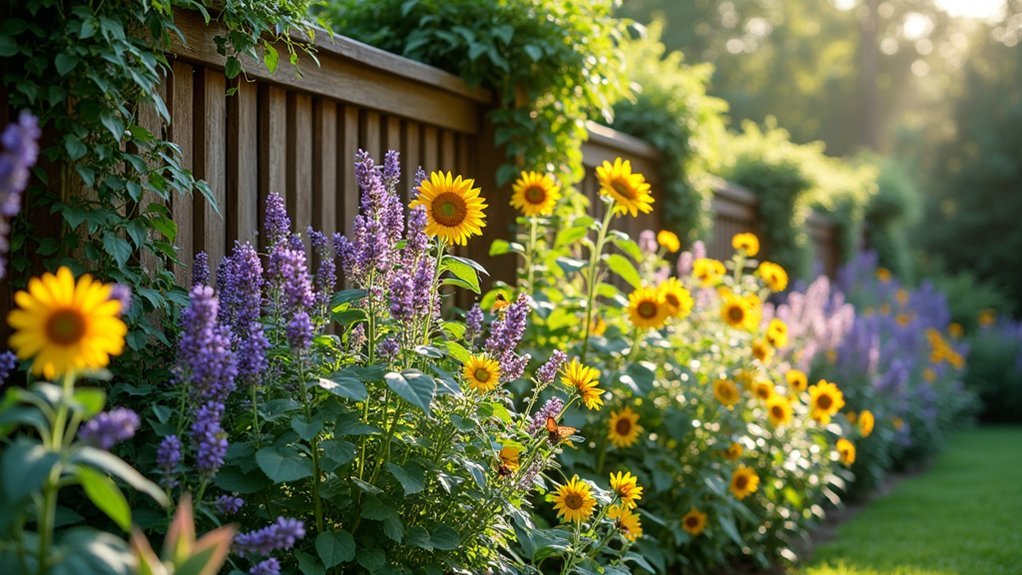
Maintaining your pollinator privacy fence throughout the year guarantees both its visual appeal and ecological function. Regular pruning encourages dense growth while proper watering sustains plant health, especially for newly established specimens. Apply mulch around plant bases to retain moisture and regulate soil temperature.
| Season | Maintenance Task | Benefits |
|---|---|---|
| Spring | Apply balanced fertilizer | Supports robust growth and blooms |
| Summer | Deep watering during dry spells | Prevents stress and promotes resilience |
| Fall | Light pruning and mulch refresh | Prepares plants for winter dormancy |
| Winter | Monitor for pests and diseases | Enables early intervention before spring |
Remember that early detection of problems prevents serious infestations that might harm your plants and deter pollinators. Your consistent care guarantees your living fence remains a thriving habitat and privacy screen year-round.
Creating Microhabitats Within Your Boundary Plantings
While privacy often drives the decision to install a living fence, your boundary plantings can serve a much greater purpose by hosting diverse microhabitats for local wildlife.
By layering tall shrubs like Viburnum with shorter native plants such as milkweed, you’ll create complex habitats where different pollinators thrive.
Layered native plantings transform ordinary boundaries into thriving wildlife sanctuaries where nature’s essential workers flourish.
Skip Laurel offers both privacy and shelter, while Blueberry bushes provide food and nesting opportunities.
Don’t forget to include plants that flower at different times—Anise Hyssop and Butterfly Bush attract pollinators from spring through fall.
Regular pruning guarantees continuous blooming cycles, maintaining your living fence’s effectiveness year-round.
Your privacy boundary can become an ecological powerhouse when you thoughtfully combine plant varieties.
This strategic approach doesn’t just screen your yard from view—it creates a vibrant ecosystem supporting essential pollinators in your local environment.
Multi-Purpose Plants: Privacy, Pollinators, and Edibles
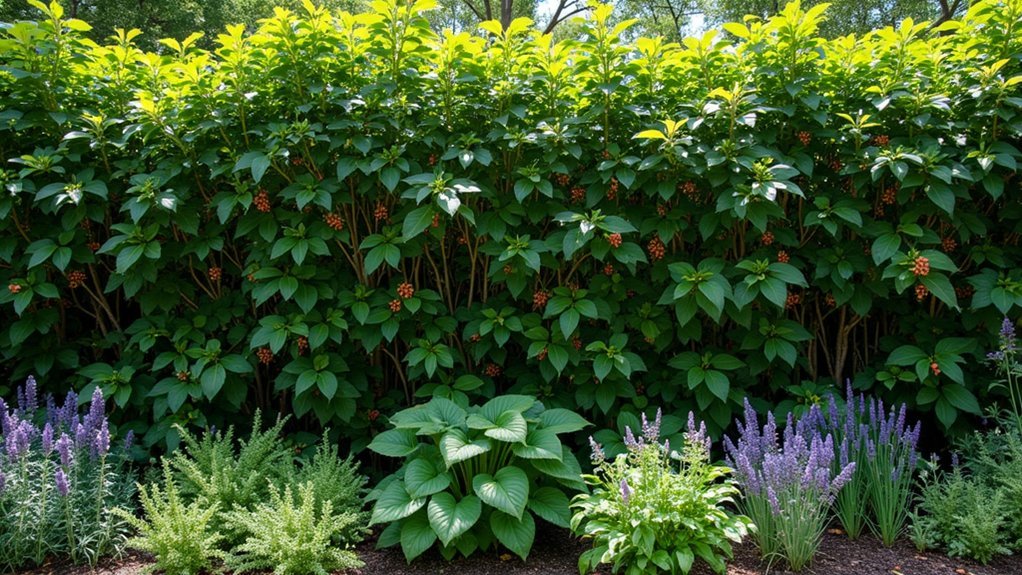
When you select plants that serve multiple functions, your privacy fence transforms from a simple boundary into a productive ecosystem.
Blueberry bushes offer delicious harvests while their dense green leaves create screening perfect for privacy in sunny spots. Viburnums provide both visual barriers and important food sources for pollinators with their showy blooms and berries.
Don’t overlook privet’s fast-growing nature, which quickly establishes a living wall while supporting birds and beneficial insects.
Butterfly bush adds fragrant beauty to your boundary while attracting numerous pollinators throughout its blooming season. For monarch conservation, incorporate milkweed—its structure offers privacy while serving as vital habitat for caterpillars.
These multi-tasking plants create boundaries that work harder for you and the environment simultaneously.
Frequently Asked Questions
What Plants Are Good for Year-Round Privacy?
For year-round privacy, you’ll get excellent results with Emerald Green Arborvitae, Green Giant Arborvitae, Skip Laurel, Leyland Cypress, and Privet. They all maintain dense foliage throughout the seasons to shield your property effectively.
What Is the Best Plant for a Privacy Fence?
Emerald Green Arborvitae is your best privacy fence option. It’s dense, maintains its bright green color year-round, grows 12-15 feet tall, and doesn’t require much maintenance. Green Giant Arborvitae works for taller barriers.
What Plant Attracts the Most Pollinators?
Milkweed attracts the most diverse pollinators, especially monarch butterflies. You’ll see it host caterpillars while providing nectar for adult butterflies. It’s essential for monarch survival and draws many other beneficial insects too.
What Are the Fastest Growing Plants for Privacy Screen?
Green Giant Arborvitae and Leyland Cypress are your fastest privacy options, growing 3-5 feet annually. You’ll also get quick coverage from Privet, which establishes rapidly, and Skip Laurel with its dense year-round foliage.
In Summary
By planting a living privacy fence, you’re creating a win-win solution for your yard and local ecosystem. You’ll enjoy enhanced privacy, beautiful colors, and the satisfaction of supporting essential pollinators year-round. Remember to combine evergreens with seasonal bloomers, incorporate native species, and maintain your living boundary regularly. With thoughtful planning, your pollinator privacy fence will become a thriving habitat that serves multiple purposes in your landscape.

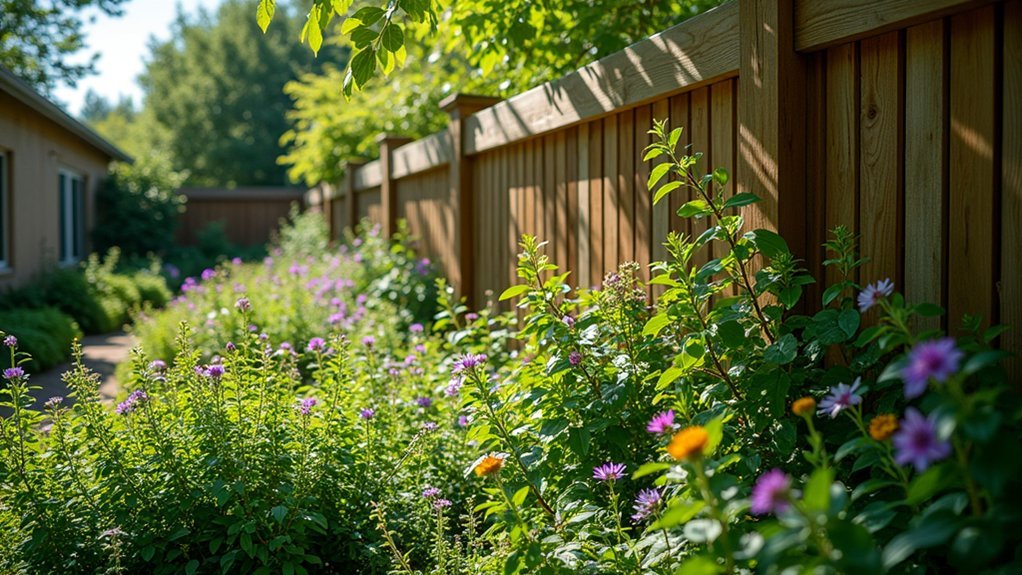



Leave a Reply